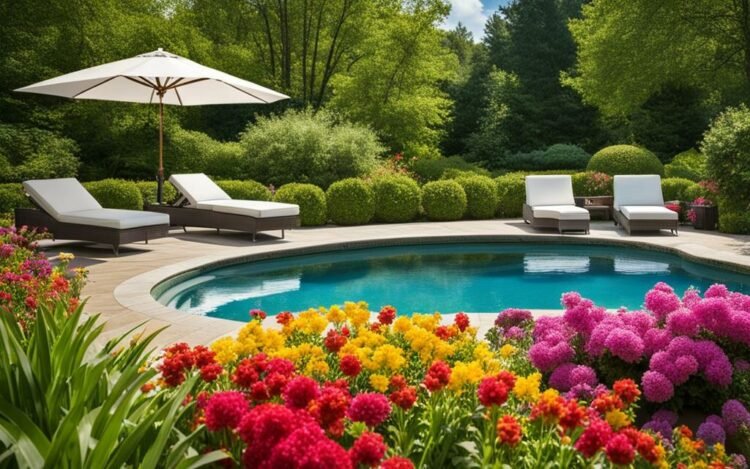Adding a swimming pool to your home is an exciting project that can bring years of enjoyment for your family and friends. However, the process of installing and maintaining a pool can seem overwhelming if you don’t have the right information and guidance. That’s where this comprehensive guide comes in. Whether you’re a first-time pool owner or looking to upgrade your existing pool, this guide will provide you with all the essential information you need.
Key Takeaways:
- Choosing the right type of pool for your needs is crucial. Consider factors such as cost, aesthetics, and available space.
- Proper planning and timelines are essential for a smooth pool design and construction process. Consult with experts and obtain necessary permits.
- Enhance the look of your pool area with well-thought-out landscaping, incorporating elements like rock formations and waterfalls.
- Ensure pool safety by installing appropriate barriers such as pool fences and alarms.
- Maintaining your pool regularly is key to keeping the water clean and safe. Understand the necessary maintenance tasks and use the right pool chemicals.
- Installing a home swimming pool is a significant investment. Research and consider all the costs involved, including installation, maintenance, and potential additional features.
Now that you have a brief overview, let’s dive deeper into each section and equip you with the knowledge and confidence to embark on your pool journey. Whether you’re looking to relax, exercise, or entertain, a home swimming pool can be a wonderful addition to your lifestyle. Let’s get started!
Types of Pools
Choosing the right type of pool for your home is an important decision. There are two main options to consider: inground and above-ground pools. Both have their own advantages and considerations to keep in mind.
Inground Pools
Inground pools are a popular choice for homeowners who want a permanent and aesthetically appealing addition to their backyard. These pools are built into the ground and can be customized to suit your preferences. One of the key benefits of inground pools is the wide range of materials available. The three common options are:
- Fiberglass: Fiberglass pools are pre-made and installed in one piece. They are known for their durability and low maintenance requirements.
- Vinyl Liner: Vinyl liner pools consist of a vinyl liner that is installed over a frame. They offer more design flexibility and are generally more affordable.
- Gunite: Gunite pools are constructed by spraying a mixture of concrete and sand onto a grid of rebar. They are highly customizable and can be designed to fit any shape or size.
Above-Ground Pools
Above-ground pools are another popular choice, especially for homeowners who are looking for a more affordable and temporary solution. These pools are installed above the ground and can be easily dismantled or moved if needed. While they may not offer the same level of customization as inground pools, above-ground pools come in various sizes and shapes to suit different needs.
When deciding between inground and above-ground pools, consider factors such as budget, desired lifespan, maintenance requirements, and the overall look you want to achieve in your backyard. It’s important to weigh all the pros and cons before making a final decision.
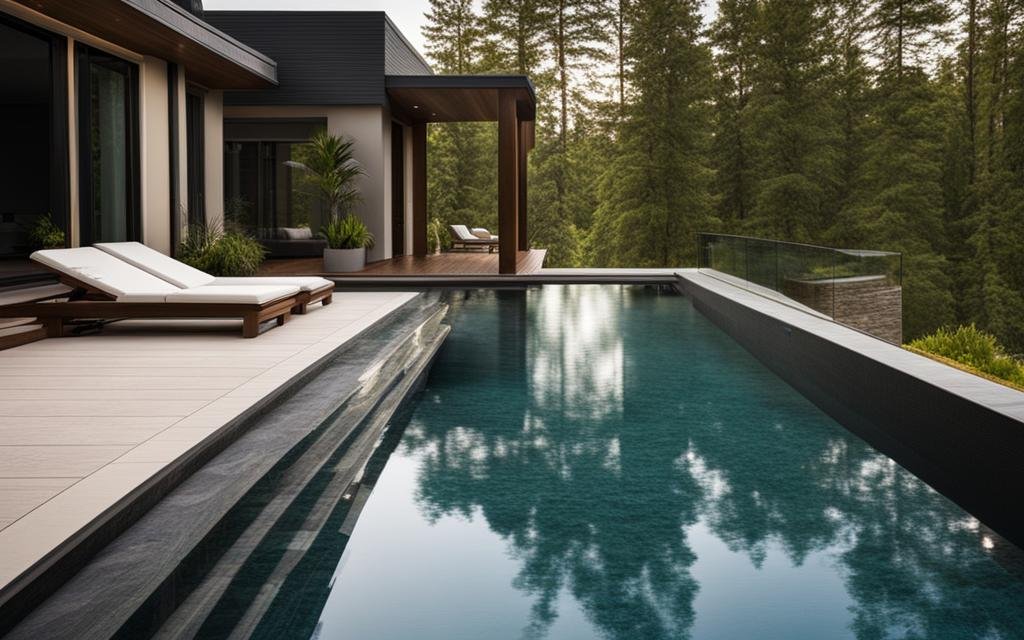
Planning & Timelines for Your Pool’s Design & Construction
When it comes to designing and constructing your dream pool, proper planning is key. From the initial pool design to the final stages of construction, following a timeline will ensure a smooth and efficient process. Here’s a breakdown of the key steps and timelines involved in creating your perfect pool:
1. Pool Design (2-4 weeks)
The first step in the pool construction process is designing your pool. This involves working with a professional pool designer who will assess your backyard space, discuss your preferences, and create a detailed plan for your pool. The pool design phase typically takes around 2 to 4 weeks, depending on the complexity of your project.
2. Permits and Approvals (4-8 weeks)
Once you have finalized the pool design, the next step is obtaining the necessary permits and approvals. This process can vary depending on your location and local regulations. It typically takes around 4 to 8 weeks to complete all the necessary paperwork, including obtaining permits, ensuring compliance with zoning laws, and addressing any other requirements.
3. Pool Construction (8-12 weeks)
With the permits in place, it’s time for the actual construction of your pool. The construction phase involves excavation, laying the foundation, installing the pool shell, and completing any additional features or amenities. The duration of the construction process can range from 8 to 12 weeks, depending on the size and complexity of your pool and any additional features you have chosen.
By following these timelines and working closely with a reputable pool contractor, you can ensure that your pool is designed and constructed efficiently, allowing you to enjoy your backyard oasis in no time.
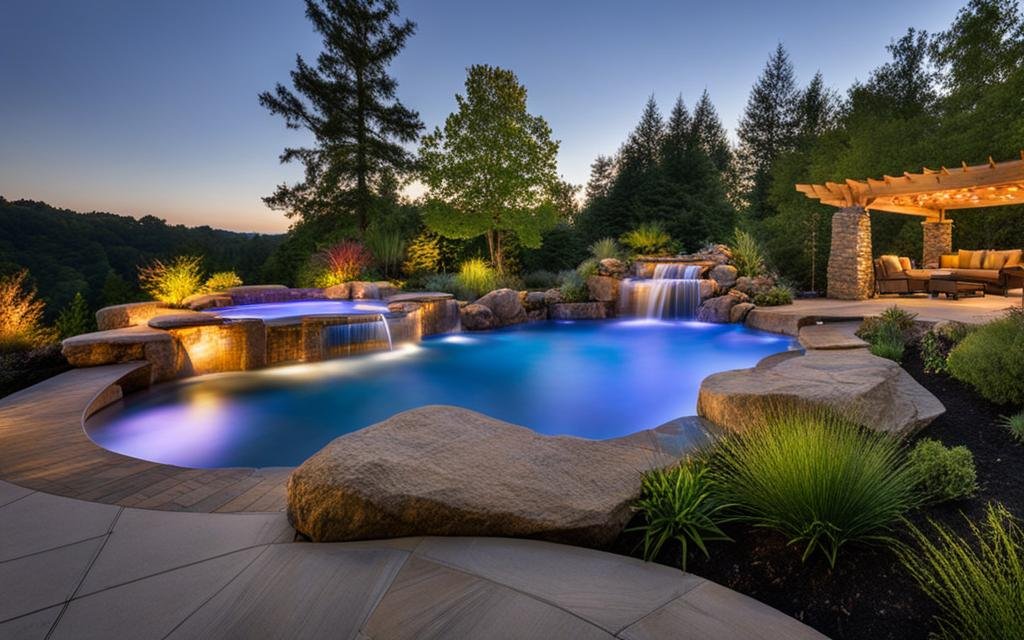
Pool Landscaping & Design Ideas
Enhancing the area around your pool with thoughtful landscaping can transform your backyard into a tranquil oasis. Whether you prefer a tropical paradise or a modern retreat, there are numerous design ideas to suit your style. Consider incorporating the following pool landscaping elements to create a stunning and inviting pool area:
1. Lush Greenery
Add lush green plants and trees around your pool to create a natural and serene environment. Consider using palm trees, ferns, or bamboo for a tropical feel, or opt for evergreen shrubs and colorful flowers for a more traditional look. Greenery not only adds beauty but also provides privacy and shade, making your pool area more enjoyable.
2. Water Features
Integrating water features into your pool area can elevate the overall design and create a soothing atmosphere. Consider adding a waterfall feature, either built into the pool or as a standalone element. The sound of cascading water can create a sense of tranquility and help mask any noise from the surrounding area. Additionally, a fountain or bubbling rock feature can add visual interest and create a relaxing ambiance.
3. Hardscaping and Pavers
Hardscaping elements, such as stone or concrete pavers, can add elegance and functionality to your pool area. Choose materials that complement your home’s architecture and blend well with the overall design theme. Pavers can be used to create pathways, lounging areas, and even outdoor kitchens or fire pits, enhancing the functionality and aesthetics of your pool space.
4. Lighting
Proper lighting can enhance the ambiance of your pool area and extend its usability into the evening hours. Consider installing underwater LED lights within the pool itself to create a magical effect at night. Additionally, strategically placed landscape lighting can highlight key features, such as waterfalls, plants, or architectural elements, adding depth and dimension to your pool design.
With careful planning and a touch of creativity, you can create a pool area that not only complements your home but also provides a relaxing and inviting space for you and your family to enjoy.
Pool Safety
When it comes to owning a pool, safety should always be a top priority. Protecting your loved ones, especially children and pets, from potential accidents is essential. Here are some crucial pool safety measures you should consider:
1. Install a Pool Fence
A pool fence is an effective way to prevent unwanted access to the pool area. It acts as a physical barrier, reducing the risk of accidents. Make sure the fence is at least 4 feet high and has a self-closing, self-latching gate. Regularly check the fence for any damage or openings that need to be repaired.
2. Use Pool Alarms
Pool alarms are another layer of protection that can alert you if someone enters the pool unattended. There are different types of pool alarms available, such as surface wave alarms and perimeter alarms. These devices can detect any movement or disturbance in the water and notify you immediately.
3. Teach Water Safety
Education plays a vital role in preventing accidents. Teach your children about water safety rules and ensure they understand the importance of never swimming alone or without supervision. Enroll them in swimming lessons to enhance their swimming skills and water awareness.
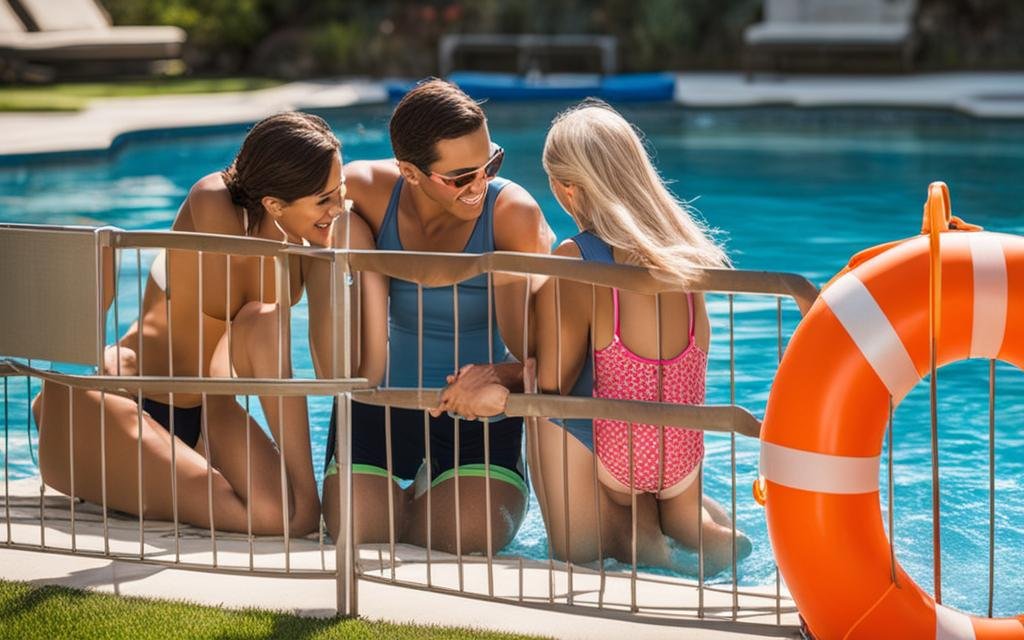
By implementing these pool safety measures, you can create a secure swimming environment for everyone in your household. Remember, consistent supervision and responsible behavior around the pool are crucial for a safe and enjoyable swimming experience.
Pool Maintenance & Cleaning
Maintaining and cleaning your home swimming pool is essential to ensure its longevity and keep the water clean and safe. By following these pool maintenance tips, you can enjoy a crystal-clear pool all season long.
1. Regular Circulation
Proper circulation is vital to prevent algae growth and distribute chemicals evenly throughout the pool. Run the pool pump and filter system for at least 6 to 8 hours a day to maintain optimal water flow. Be sure to clean out the skimmer and pump baskets regularly to remove any debris that may impede circulation.
2. Cleaning and Skimming
Skimming the pool surface and removing debris like leaves, bugs, and twigs is a crucial part of pool maintenance. Use a skimmer net or leaf rake to skim the water’s surface daily. Additionally, invest in a pool vacuum or robotic cleaner to keep the pool floor and walls free from dirt and algae buildup. Brushing the walls and tiles regularly can also help prevent the formation of algae and calcium deposits.
3. Proper Chemistry
Maintaining the proper chemical balance in your pool is vital for clear and safe water. Regularly test the water’s pH, alkalinity, and chlorine levels using a pool testing kit. Adjust the chemicals as needed to keep the water balanced. It’s important to note that excessive chemicals can be harmful, so follow the manufacturer’s instructions and consult a professional if needed.
By following these pool maintenance practices, you can keep your pool clean and inviting for your family and friends to enjoy. Remember to always prioritize safety and follow the manufacturer’s guidelines for any pool cleaning or chemical products.
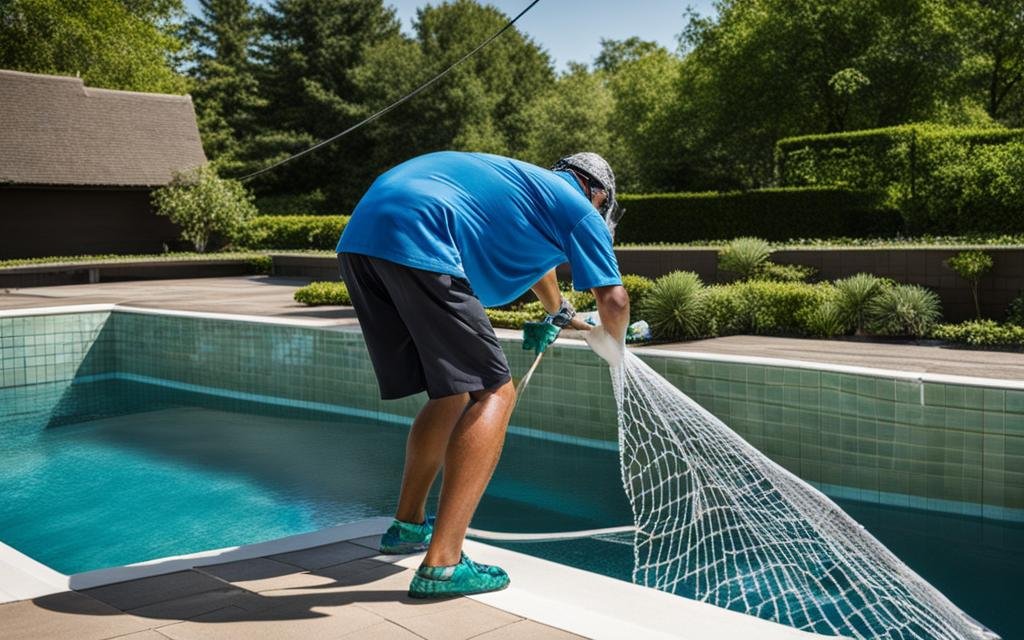
Costs & Pricing
Installing a home swimming pool is a dream come true for many homeowners, but it’s essential to consider the costs and pricing involved. The overall cost of a pool installation can vary depending on several factors, including the type of pool, size, materials, additional features, and labor costs. To help you plan and budget for your pool project, here’s an overview of the key cost considerations:
1. Pool Type:
There are different types of pools to choose from, including inground and above-ground options. Inground pools tend to be more expensive due to the excavation work involved and the use of higher-quality materials. Above-ground pools are generally more affordable and easier to install. The material you choose for your inground pool, such as fiberglass, vinyl liner, or gunite, will also impact the cost.
2. Size and Shape:
The size and shape of your pool will affect the overall cost. Larger pools require more materials and labor, resulting in higher expenses. Additionally, if you opt for a custom shape or design, it may incur additional costs compared to standard pool shapes.
3. Additional Features:
If you want to enhance your pool with features like waterfalls, slides, lighting, or heating systems, it’s important to factor in the additional expenses. These features can significantly contribute to the overall cost but can also enhance your swimming experience.
4. Maintenance and Upkeep:
Remember to consider the long-term costs associated with pool maintenance and upkeep. This includes the cost of chemicals, water treatments, cleaning equipment, and regular servicing. It’s essential to budget for these ongoing expenses to ensure the longevity and proper functioning of your pool.
Conclusion
In conclusion, this comprehensive guide serves as a valuable resource for anyone considering a home swimming pool. Whether you’re dreaming of a refreshing oasis to escape the summer heat or looking to enhance your backyard, this guide covers all aspects of your pool journey.
From exploring the different types of pools, such as inground and above-ground, to understanding the materials used in pool construction, this guide provides the necessary information to make informed decisions. It also helps you plan and navigate the various stages of pool design and construction, ensuring a smooth process from start to finish.
Once your pool is completed, this guide offers insights into pool landscaping and design, helping you create a visually stunning and inviting pool area. Safety is paramount, and this guide highlights important measures like pool fencing and alarms to keep your loved ones safe.
Maintaining your pool’s cleanliness and water quality is crucial, and this guide provides valuable tips on pool maintenance and cleaning, including proper circulation and chemical balance. Additionally, it provides insights into pool costs and pricing, giving you a better understanding of the financial aspects of your pool project.
So, start your pool journey today and transform your backyard into a haven for relaxation and enjoyment. This comprehensive guide is your go-to resource, providing all the information you need to make your home swimming pool a reality. Dive in and make your pool dreams come true!

